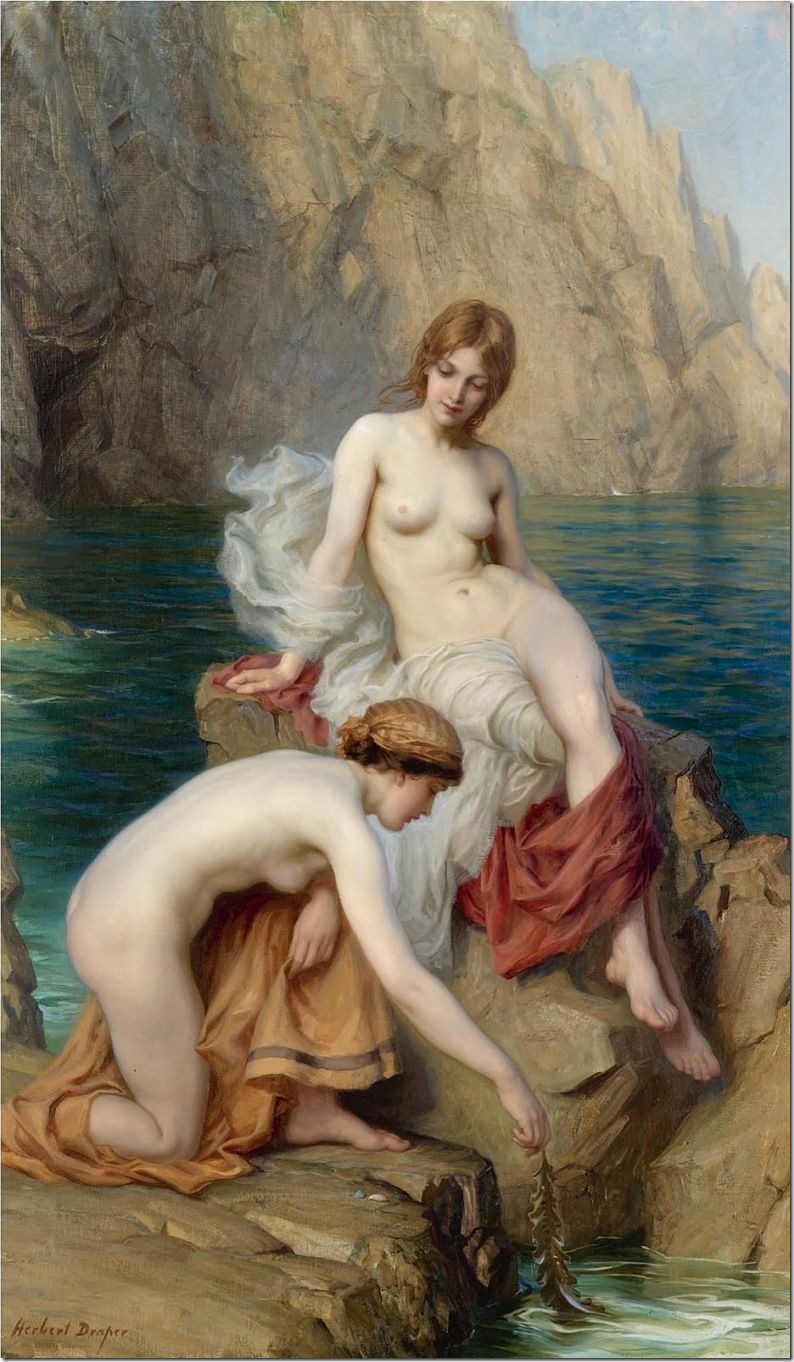
英國維多利亞時代的宮廷畫家Herbert James Draper黑爾伯特.詹姆斯.德拉波(1863-1920)以繪畫海上女妖( sirens)、人魚(mermaids)的等相關系列畫作聞名。
德拉波Born in London.出生于倫敦。曾就讀于曾聖約翰伍德藝術學校,並于1884年進入Royal Academy學習。經過幾年在西班牙,摩洛哥,意大利,法國,荷蘭和比利時的游歷後,回國在肯辛頓成立了一個畫室。他1894年在Royal Academy展出了他的‘The Sea Maiden’獲得了第一次公開的成功,並成為當時非常受歡迎的畫家。萊斯特畫廊1913年舉辦了德拉波的回顧展覽。 德拉波于1920年9月22日逝世于倫敦。
Herbert James Draper (1864-1920)

Herbert James Draper.
Herbert James Draper was a late follower of the Pre-Raphaelites and the Classicists whose paintings are often similar to those of John William Waterhouse, featuring beautiful innocent-looking girls with long dark hair. His work also shows the influence of Lord Leighton and Burne-Jones.
He was born in London and studied science before turning to art, first at St John's Wood School, and then at the RA Schools (from 1884), where he won a prize for decoration of a public building with a scheme which was later carried out at Guys Hospital, London. In 1889 he won a Royal Academy travelling scholarship, and went to Spain, Italy, France, Holland and Belgium. He actually decided to live abroad to paint in the beautiful light of Italy, but wrote to Lord Leighton first to ask his advice. Leighton - no stranger to travel - advised him that there was no light for painting like the light of an English summer, and this was enough to persuade the younger man to abandon the life on the Continent.
Draper married a Miss Ida Williams, and they had one daughter. From 1896 they lived in Abbey Road, St John's Wood, London, neighbours of John William Waterhouse.
Draper exhibited at the Royal Academy from 1887, and continued to show pictures there for the rest of his life. He specialised in nymphs, beautiful and nude, typically in a nautical setting, but was also a portrait painter and occasionally produced rather unworthy sentimental pictures of children.
Draper's paintings have a charm and appeal and often light-heartedness that makes them in some ways more easily acceptable to modern taste than some of the more heavy-going, serious subjects of his competitors. However, he took great pains over the background for his pictures. For example, writing about his picture The Sea Maiden (1894), an illustration of a poem by Swinburne showing sailors hauling in their nets and discovering a sea-girl therein, Draper wrote:
"I took the usual pains in gathering my studies, spending hours in a boat with a fishing net floating in the water over a couple of spars. I made my studies at sea off Devon and the Scillies (the latter the more useful) and I spent some time on a Devon trawler to see the nets hauled with the fish - a roughish sort of experience, as they go for 48 hours at a stretch. My barbaric or archaic boat I was, of course, unable to get, so I modelled it in wax and coloured it, and then studied it out of doors."
The Sea Maiden was the painting that established Draper's reputation. His best-known paintings are The Lament for Icarus, now in the Tate Gallery, and The Sirens, now in Hull, which is one of the best paintings in the 'femmes fatales' idiom, showing the sirens as young maidens actually climbing into the ship with Odysseus. The scene 5 minutes before, with the sirens still in the water, is in Leeds. In the Manchester art gallery is A Water Baby, with a vaguely aquatic nymph discovering a baby in a huge shell, and Calypso's Isle. A study for The Lament for Icarus and The Kelpie are at the Lady Lever Gallery. The Golden Fleece is in the Bradford Art Gallery, and The Sea Maiden is in the Royal Truro Museum, Cornwall.
Draper also did some book illustration - in particular, sketches for ice-skating in the English Illustrated Magazine in 1893, and drawings to accompany poetry in art magazines.

沒有留言:
張貼留言
注意:只有此網誌的成員可以留言。